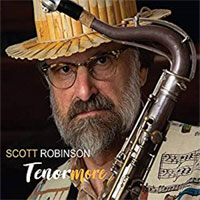Scott Robinson • Tenormore
 ne of the pleasures of
Frank Kimbrough’s recent six-CD Monk’s
Dreams was hearing Scott Robinson work out on six reed and brass instruments, from
echo cornet (look it up) to contrabass sarrusophone. That sonic breadth hints at his broad
interests, traditional jazz to 1960s Sun Ra. Narrowing his focus for Tenormore, Robinson sticks to one horn -- his
beloved 1924 Conn tenor saxophone -- fronting a nimble trio without a weak link: pianist
Helen Sung, bassist Martin Wind, drummer Denis Mackrel. ne of the pleasures of
Frank Kimbrough’s recent six-CD Monk’s
Dreams was hearing Scott Robinson work out on six reed and brass instruments, from
echo cornet (look it up) to contrabass sarrusophone. That sonic breadth hints at his broad
interests, traditional jazz to 1960s Sun Ra. Narrowing his focus for Tenormore, Robinson sticks to one horn -- his
beloved 1924 Conn tenor saxophone -- fronting a nimble trio without a weak link: pianist
Helen Sung, bassist Martin Wind, drummer Denis Mackrel.
A horn that old has a patina. So does Robinson’s sound: syrup-smooth but not heavy, with a barely suppressed rasp. Singing legato phrasing complements his lag-the-beat swing. The tenor timbre and the improviser’s graceful bearing recall vintage Clifford Jordan, no bad thing. Robinson may tailor each note in a line, varying its thickness, tone, vibrato or volume. He knows the tenor’s emotional range too, wounded cry to soothing consolation, even in a single phrase. A student of its overtones, he may slide into a split-tone passage reminiscent of Tibetan throat singing. Or he’ll leap into the altissimo register -- in soprano-sax territory but with much more belly in the sound -- to play a single grace note, or whole high-wire passages, more steely than squealy. His blues melody “Tenor Twelve” veers across the horn’s range, many phrases ascending to a toot-toot hook. Every improvised chorus is a mini-essay in thematic development. The companion blues, “Tenor Eleven,” comes up a bar short, without sounding hobbled. On “The Weaver,” he mixes staccato and slinky attacks, and twines his line around wife Sharon Robinson’s twisty, scored flute part. The flute-tenor harmony makes for sonic variety, and makes a metaphor for their marriage. That abridged blues speaks to Robinson’s playfulness, which really comes out on four standard ballads, each approached from an oblique angle. He sneaks up on Sacha Distel’s “The Good Life” via a rubato intro that doesn’t give the melody away. (The tune’s plunging phrases suit Robinson’s sturdy-in-all-registers sound.) The Beatles’ “And I Love Her” is unaccompanied tenor, with George Harrison’s intro/outro riff sounded in that dramatic high register. Robinson plays the feel-good “Put on a Happy Face” in a drowsy, Marilyn Monroe “Happy Birthday, Mr. President” tempo, with understated delivery to match. He mostly plays these ballads straight -- with a few squiggly embellishments on the McCartney tune -- while letting his mates have at them. On “Happy Face,” Sung’s piano solo peeks around the corners of the melody, gossamer-light. If this review concentrates on the leader, it’s not because he hogs the solos, but because the band lets him have his day. Mackrel’s hi-hat chomp and snare chatter can be as discreet as his feathering ride cymbal, but he’s ever present, reacting and pushing. Perversely, Hoagy Carmichael’s tender “The Nearness of You” gets a bumping eighth-note rhythm, snare accents on 3 and 7, with Wind’s burping bass guitar, and Sung on Hammond B3, on which she comes off as a real jazz organ player -- holding sustained chords to soak the atmosphere -- and not a dabbling pianist. There are also two fine original ballads. Scott’s
“Morning Star” could pass for a show tune. Martin Wind’s “Rainy
River,” with Sung again on (churchy) organ, has a loping cowpoke feel and melody
worthy of 1990s Bob Dylan. (It’s even in the folky key of A major.) The medium lope
is a sweet spot for bass players, and Wind roams the prairies. His time sense is very
good, ditto his intonation and clean attack, recorded to sound natural -- unlike his
plugged-in acoustic bass guitar, also deployed on the 11-minute stretcher
“Tenormore.” (I like the instrument -- but let it sound like an acoustic
guitar.) Wind’s contrabass volume level is realistic, and the drums sound like
Mackrel’s in the same room with everyone else. The mix places the leader a little out
front, as befits the program. |
